Desert Pupfish
-
Scientific NameCyprinodon macularius
-
NativeYes
-
Identification
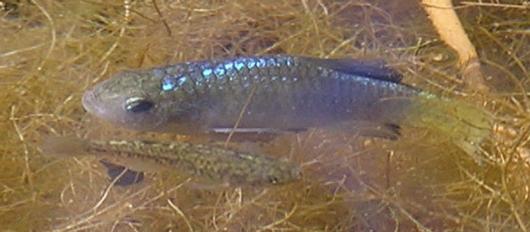 Desert pupfish, male and female. Location: Borrego Springs High School Pond. Date: May 2010. Photo by Sharon Keeney, California Department of Fish and Game.
Desert pupfish, male and female. Location: Borrego Springs High School Pond. Date: May 2010. Photo by Sharon Keeney, California Department of Fish and Game.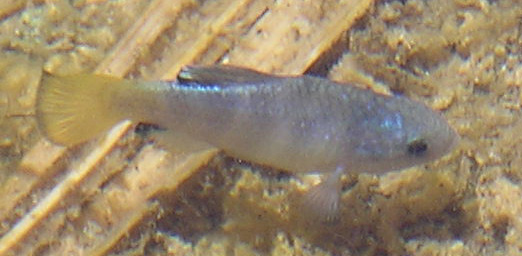 Desert pupfish, male, breeding coloration. Location: Borrego Palm Canyon Pond, Anza-Borrego Desert State Park. Date: May 2010. Photo by Sharon Keeney, California Department of Fish and Game.
Desert pupfish, male, breeding coloration. Location: Borrego Palm Canyon Pond, Anza-Borrego Desert State Park. Date: May 2010. Photo by Sharon Keeney, California Department of Fish and Game.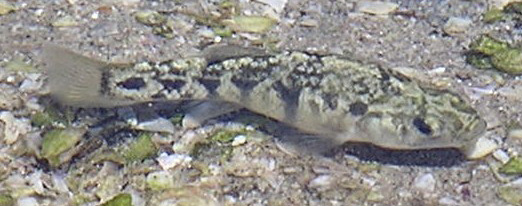 Desert pupfish, female. Location: Arthur 0.5 Drain, Salton Sea. Date: Summer 2006. Photo by Sharon Keeney, California Department of Fish and Game.
Desert pupfish, female. Location: Arthur 0.5 Drain, Salton Sea. Date: Summer 2006. Photo by Sharon Keeney, California Department of Fish and Game.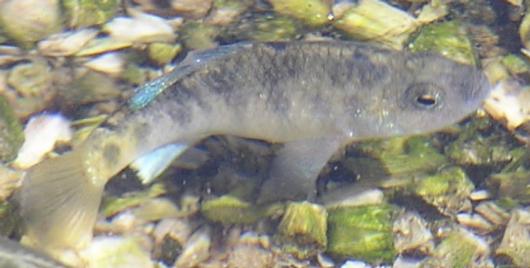 Desert pupfish, male. Location: Arthur 0.5 Drain, Salton Sea. Date: Summer 2006. Photo by Sharon Keeney, California Department of Fish and Game.
Desert pupfish, male. Location: Arthur 0.5 Drain, Salton Sea. Date: Summer 2006. Photo by Sharon Keeney, California Department of Fish and Game.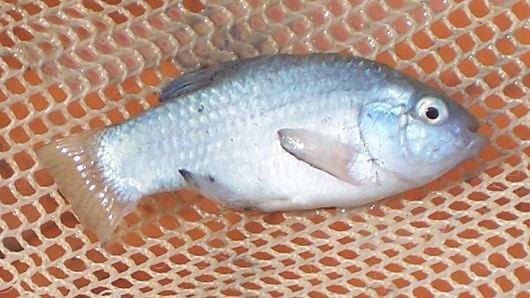 Desert pupfish, adult male in breeding coloration (silver blue color). Captured from the USGS/BOR Shallow Habitat Project experimental ponds on the southeast side of the Salton Sea, CA,on 04/27/2009. Photo by Barbara A. Martin, USGS.
Desert pupfish, adult male in breeding coloration (silver blue color). Captured from the USGS/BOR Shallow Habitat Project experimental ponds on the southeast side of the Salton Sea, CA,on 04/27/2009. Photo by Barbara A. Martin, USGS.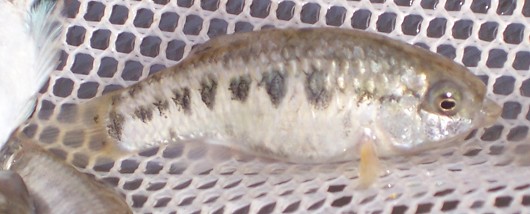 Desert pupfish, adult female, in seine net with other fish. Captured from the USGS/BOR Shallow Habitat Project experimental ponds on the southeast side of the Salton Sea, CA on 04/27/2009. Photo by Barbara A. Martin, USGS.
Desert pupfish, adult female, in seine net with other fish. Captured from the USGS/BOR Shallow Habitat Project experimental ponds on the southeast side of the Salton Sea, CA on 04/27/2009. Photo by Barbara A. Martin, USGS.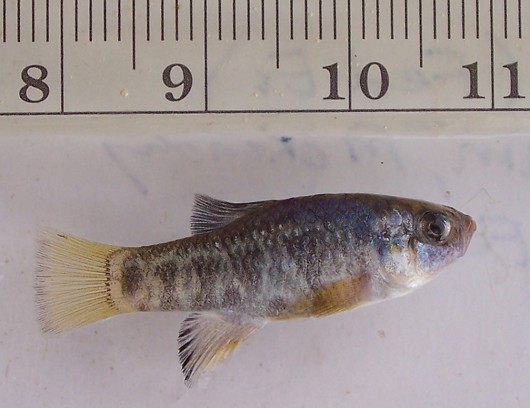 Desert pupfish, adult male losing his breeding colors. Captured from an irrigation drain leading to the Salton Sea, CA, on 07/11/2008. Photo by Cory Emerson, USGS. Note: Scale is in centimeters.
Desert pupfish, adult male losing his breeding colors. Captured from an irrigation drain leading to the Salton Sea, CA, on 07/11/2008. Photo by Cory Emerson, USGS. Note: Scale is in centimeters.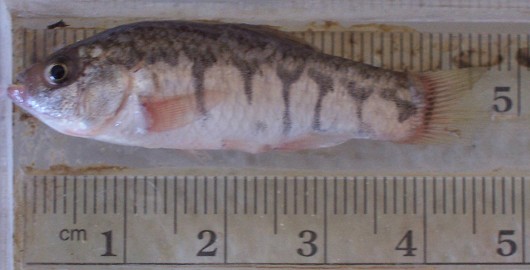 Desert pupfish, adult female. Photographed on 05/31/2009 by Barbara A. Martin, USGS.
Desert pupfish, adult female. Photographed on 05/31/2009 by Barbara A. Martin, USGS.- Small, chunky, max 75 mm TL (males larger than females)
- Circuli on large scales have spines, interspaces lack reticulations
- Dorsal fin is equidistant from base of tail and tip of snout
- One full row of tricuspid incisor-like teeth
- Coloration (sexual dimorphism present):
- Breeding male: blue with lemon yellow tail and caudal peduncle, 5-8 faint vertical bars along sides, black band on posterior end of caudal fin
- Breeding females: tan to olive, 5-8 vertical bars more prominent
- Fin rays: dorsal 9-12, anal 9-12, pectoral 14-18, caudal 14-20, pelvic 2-8
- Lateral series scales: 25-26
-
Life History
Desert Pupfish are a hearty species capable of surviving extreme environmental fluctuations. They can tolerate temperatures from 7°C up to 45°C, salinities ranging from 0 to 70 ppt, and oxygen levels from saturation down to 0.1-0.4 mg/L. Desert Pupfish can live through daily temperature fluctuations of 26°C and changes in salinity of 10 to 15 ppt. Larval pupfish can survive sudden salinity changes of 35 ppt and total salinities as high as 90 ppt. Despite their adaptability, Desert Pupfish in California are only found in small isolated populations. Favorable waters are calm, though Desert Pupfish are often found in polluted and fluctuating conditions. Pupfish usually form loose shoals and tend to have a size dependent spatial distribution. In the Salton Sea smaller fish swim together in shallow zones whereas larger fish swim in deeper water. During the breeding season male fish become territorial and shoals are made up of primarily female and juvenile pupfish. In the Salton Sea, Desert Pupfish migrations and feeding are largely temperature dependent. In the early morning and late evening pupfish forage in shallow zones. They move out of the shallows during the middle of the day when water temperatures may rise to 36°C. The diet of a Desert Pupfish may include algae, small invertebrates, aquatic crustaceans, aquatic insect larvae, snails, and detritus. Desert Pupfish grow rapidly and can complete their life cycle in a single summer under optimal conditions. They may become sexually mature at 15 mm SL, but most don’t breed until they are at least 30-50 mm SL. At the end of one growing season they may reach a maximum total length of 45-50 mm. Spawning occurs from April to October. Spawning typically takes place when water temperatures begin to exceed 20°C. Some males defend territories and try to entice females while other males lurk along the edges waiting for a chance to fertilize. Territorial males tend to select larger females because egg production is size dependent. When a female is lured away from her shoal by a territorial male, they demonstrate a number of courtship acts before the male cups the female’s caudal peduncle with his anal fin. They shake together and the female releases a single egg. Each series of trembling acts may result in 1-4 eggs and a female may lay 50-800 eggs in a single season. Large females sometimes eat the embryos of other female pupfish. Fertilized eggs hatch in 10 days at 20°C, and the emergent larvae occupy shallow regions where they begin feeding on small invertebrates within the first day of hatching.
-
Links to Other ResearchN / A







